NVIDIA’s GeForce GTS 450: Pushing Fermi In To The Mainstream
by Ryan Smith on September 13, 2010 12:02 AM EST- Posted in
- NVIDIA
- Fermi
- GeForce GTS 450
- GF106
- GPUs
Power, Temperature, & Noise
As we’ve discussed in previous articles, with the Fermi family GPUs no longer are binned for operation at a single voltage, rather they’re assigned whatever level of voltage is required for them to operate at the desired clockspeeds. As a result any two otherwise identical cards can have a different core voltage, which muddies the situation some. All of our GTS460 cards have an idle voltage of 0.962v, while their load voltage is listed below.
| GeForce GTS 450 Load Voltage | |||||||
| Ref #1 | Ref #2 | Asus | EVGA | Palit | Sparkle | ||
| 1.05v | 1.062v | 1.125v | 1.112v | 1.087v | 1.087v | ||
As all of our vendor cards are factory overclocked, it skews the average voltage high. Among our two reference cards we see load voltages of 1.05v and 1.062v, while the overclocked cards are between 1.087v and 1.125v. As NVIDIA is making every effort to promote the overclocking capabilities of the GTS 450, this should give us a good baseline of where we want to be for the best overclocks.
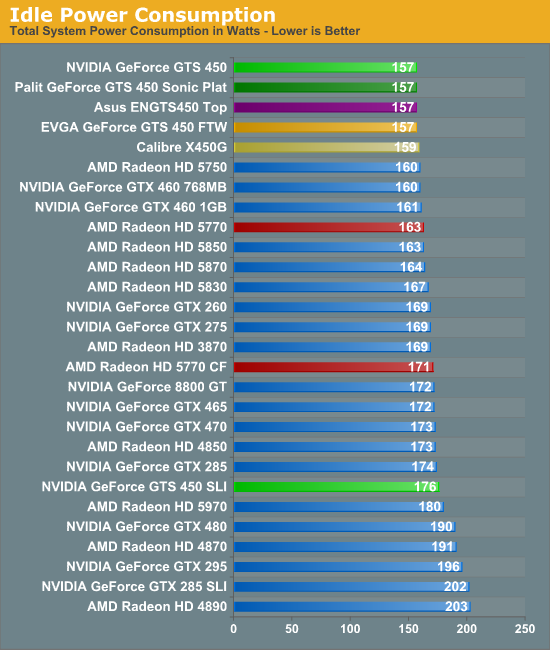
NVIDIA does not provide an official idle TDP, however it’s very clear that it must be very low. All of our GTS 450 cards bring in the lowest idle power consumption levels on this chart. We know the 5750 is rated for 16W at idle, so it’s safe to assume that the GTS 450 can beat that. Given the extremely low idle clocks of the GTS 450 (50MHz core, 270MHz memory) there’s a good chance this is the reason for the impressive idle power consumption.
We haven’t talked about SLI/CF much, but it bears mentioning here. NVIDIA doesn’t have an equivalent of AMD’s Ultra Low Power State for slave cards, which is why the GTS 450 can beat the 5770 as a single card, but lose in SLI/CF.
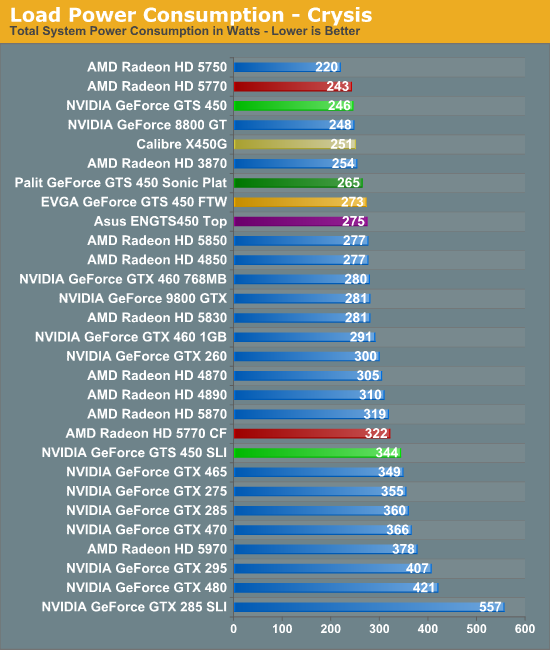

Under load the GTS 450 allows for some very low system power consumption numbers, however it can’t best the 5770. GF106 is a bigger die with more transistors so it’s not surprising that NVIDIA ends up drawing a bit more power here. But their performance also isn’t usually on par with the 5770, so they aren’t in a position to match AMD’s solid performance-per-watt. The overclocked cards do worse here of course, the worst of which is approaching 5850 power levels (and a testament to the 5850’s capabilities).
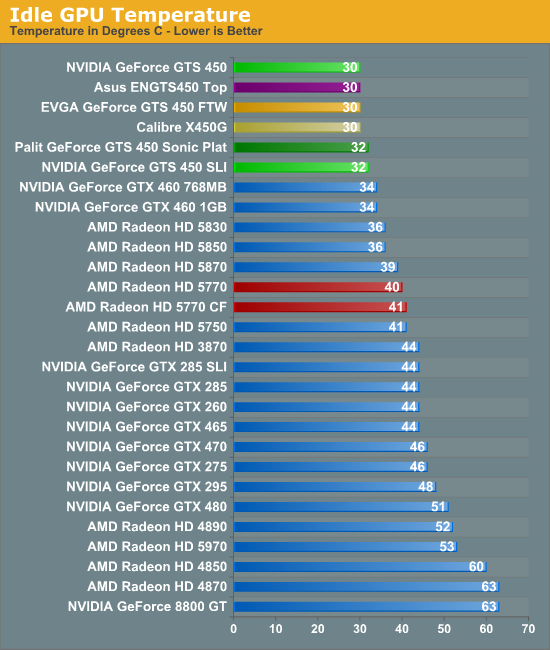
Along with giving us some of the lowest idle power numbers we’ve seen for a mainstream card, the GTS 450 also gives us the coolest temperatures. Even the GTX 460 can’t compete with the GTS 450, whose GPU barely breaks room temperature with the reference card. It’s also one of the few things the Radeon 5700 series is decidedly worse at, with the coolest of those cards getting up to 40C.
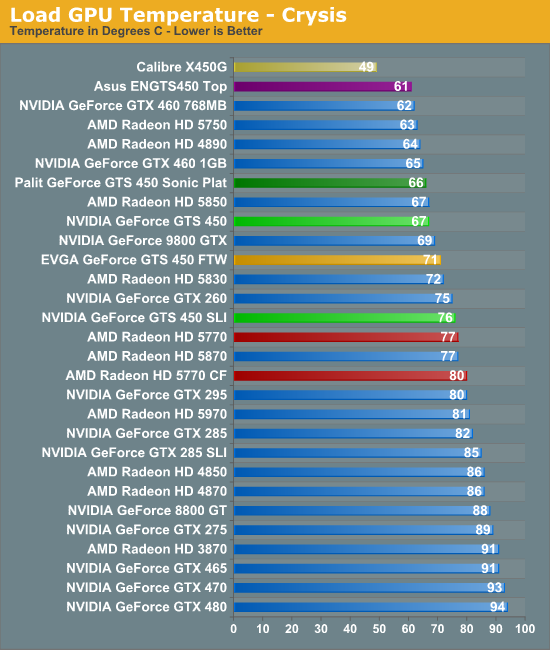

We’ll get to the Calibre card in our companion article focusing on the vendor cards, but for now we’ll stick to the reference and reference-like cards. The GTS 450 represents NVIDIA’s continued use of aggressive cooling. With a smaller all-aluminum heatsink it can’t hope to match the GTX 460, but at the same time it’s a good 10C ahead of the 5770 when it comes to Crysis. Even under Furmark the factory overclocked cards still only reach 5770 temperatures, showcasing just how good the cooling on these cards is.
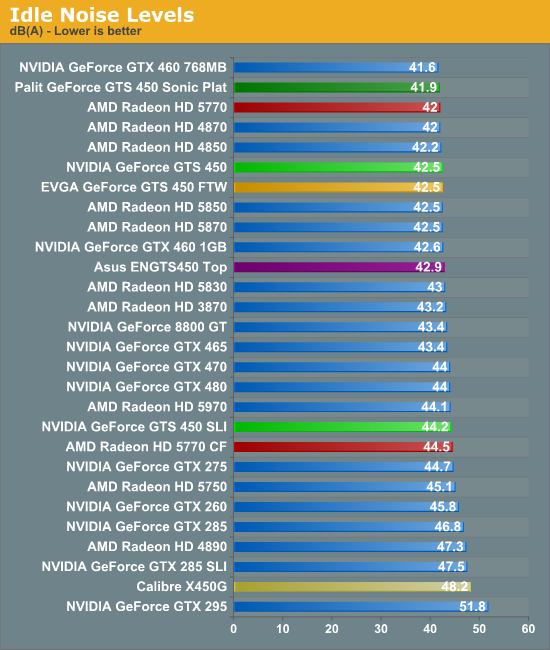
As always, the amount of noise generated at idle for a good card should be indistinguishable from other cards. The GTS 450 is no exception, generating around 42 dB(A) as we’ve come to expect.

Traditional wisdom for a video card is that if you have (relatively) high power draw you can either have a cool card or a quiet card but not both. The GTS 450 breaks the idiom wide-open – we’ve already established it draws more power than the 5770, and yet our reference card barely breaks the noise floor. At 43.3dB(A) it’s effectively silent, a feat not even the GTX 460 or the 5770 can claim. If you can ventilate your case at similarly quiet levels (necessary by fact that the GTS 450 exhausts some hot air in to the case) then we’re certainly looking at a contender for one of the most balanced HTPC cards ever.
Quickly, SLI is a bit of a different story. The reference design is great for a single card, but having two of such cards right next to each other truly suffocates the first card. We’ve said it once and we’ll say it again: if you can separate your Fermi cards, it’s in your best interest to do so.










66 Comments
View All Comments
Ryan Smith - Monday, September 13, 2010 - link
If I had my way, we'd have every card known to man on our charts. But if I had my way, days would be 50 hours long to accommodate all of that testing...In any case not having a GTS 250 is not an oversight on our part - we simply do not have a GTS 250 to test with.
Stuka87 - Monday, September 13, 2010 - link
So it seems to me like the 450 is trying to match performance with the now year old 5770. I really think nVidia should have one upped the competition, like they did with the 460 release.I just can't see this card getting the life that nVidia needs to get out of it. AMD will do a refresh long before nVidia does, which will ultimately mean the 450 will have a very short life in comparison to the 5770.
HangFire - Monday, September 13, 2010 - link
This comment is right on the mark, and part of a disturbing trend I see with new video card generations in general and Nvidia in particular. With each new generation we are getting the same performance, more or less, at the same price points, the only difference is a newer Direct X level, lower power, or less noise, or a new video connector, etc.If all you care about is getting a certain FPS in a few games on one monitor with a certain level of AA and eye candy, the older generation cards would often be a better choice, if they were only available. Unlike in previous generations, which seemed to stay in production forever even when obsolete, the best values either go away (like the 4770 or GTX 275), get recycled at the same or higher price point (8800/9800), or get replaced by similar performance at that price point (GTS 450 vs 250).
The end result is that for a give price point, you are not buying any more Frames per Second then you were 2 years ago- unless you paid too much and made a really bad choice 2 years ago.
While at first I was thrilled to see so many older cards in this review, the GTS 250 is conspicuously absent, perhaps because it is rather embarrassing to see what little new the 450 has to offer in terms of price/performance. The 450 is not yet on Bench either, though I hope that will be remedied soon.
So, congratulations Nvidia, you now have a more complete DirectX 11 lineup, but you've offered me nothing in price/performance to make me want to replace any of my DirectX 10 cards.
just4U - Monday, September 13, 2010 - link
I disagree. Annand put up numbers for the 4850 which has always pretty much walked allover the GTX250 (9800GTX 8800GTX etc) Looking at the graphs the 450 is somewhat faster so including the 250 benchmarks is not neccessary.Also, Both Ati and Nvidia seem to be in a holding pattern as far as performance goes with their current lineups. People upgrading from the latest and greatest from the last generation of video cards won't notice huge gains performance wise. What they will notice (depending on the card) is lower temperatures, less power consumption, and ofcourse more features.
Those upgrading from cards 2+ years old or value oriented cards from the last generation are likely to see the most gains overall with these new ones. The rest of us get a sideways upgrade at best. Atleast thats my opinion anyway.
geniekid - Monday, September 13, 2010 - link
I must also disagree, respectfully. A couple of the benchmarks here show that for less than half the price I paid for my top-of-the-line factory OCed 9800GTX several years ago, I can get about the same or slightly better performance. This shows me that progress is being made - or, at the very least, that price/performance is improving over time.HangFire - Monday, September 13, 2010 - link
Wow, thanks for the respect in the disagreement! But then, this is AT not Tom's.Speaking of Tom's, I just read their GTS450 review, and their statement after the DX9-10 benchmarks (CoD:MW2 and Crysis) mirrors mine vis-a-vis the GTS 250- "Naturally, numbers like this don’t compel you to upgrade." While another site quoted 20-25% better performance, Tom's had the 250 faster than the 450.
I would expect a three generation old top-of-the-line card to have poor value compared to a mainstream card of today. (I say three because a 9800 GTX OC is essentially an 8800 Ultra). Nvidia complicates the issue with generational recycling and the missing GTX 3xx DirectX 10.1 cards that never existed. I'm trying to compare like-to-like, that is mainstream cards in the $140 to $150 range (price at introduction).
If you look at the incremental performance differences of the mid-stream cards 8800GT->9800GT->GTS 250->GTS 450, anyone that actually bought each of these cards for $130->$150 expecting a big generational performance boost with each jump was sorely disappointed. On the AMD side things are a little better, but the mainstream level 4xxx to 5xxx jump was more about power and Eyefinity than performance. (Of course their top-end cards made big jumps, at big $$$).
The new GTS 450 is launched at the same price point the GTS 250 had, and offers very similar performance. Of course, the 250 dropped in price like a stone, because it had to, and the 450 may have some adjustments ahead of it. But let's say it was 25% faster across the board, is it compelling? The 7800GT to 8800GT upgrade, now that was compelling.
just4U - Monday, September 13, 2010 - link
You have to remember something though.. the 8800 line was a new standard by which all cards are/were measured by. Like the Radeon 9700/800 it takes years to move past it... We do not see those crazy bumps in performance and features happen often afterall.IceDread - Monday, September 13, 2010 - link
"The GTX 460 was a card that made the comparable AMD card obsolete and brought significantly improved performance to the $200 market. NVIDIA had a card built to hit one of AMD’s weak spots, and it struck beautifully. "A news site should strive towards being unbiased but anandtech sure does not do that.
just4U - Monday, September 13, 2010 - link
Have you had the oportunity to use the 460? Or the 5830/50 that it competes against? Anandtech hit the nail on the head with that statement and it's not based upon Ati/Nvidia bias. Simply put it's one of the best buys on the market right now and with all of Nvidia's misteps it's surprising to see them come out with a card that is so hard to pick fault with.heflys - Monday, September 13, 2010 - link
Yeah, the GTX 460 1gb made the 5830 obsolete, but the 768mb version sure didn't. And the 5850 has started to come down in price, and you can now pick it up for $259 after rebate.